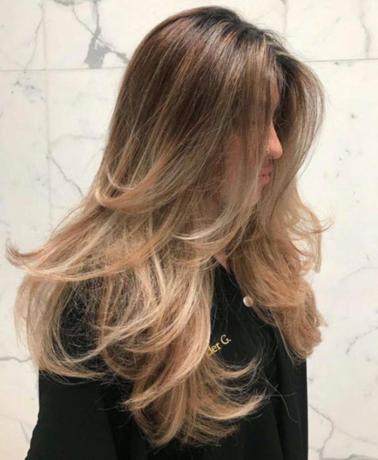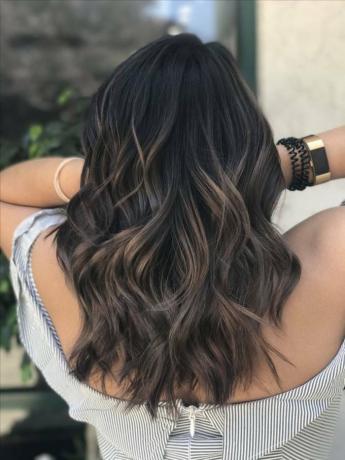The trend is again maximum naturalness, smooth color transitions and lightening no more than two tones from the natural hair color
Outside the window, finally, not a calendar, but a fine and sunny spring. Right now, women, more than ever, want to clean their feathers and change something in their appearance. Despite the lockdown, beauty salons are now full houses for recording. Most requests for hair dyeing. This procedure can really work wonders. With a new color, a woman often feels differently. However, stylists do not recommend rushing to extremes and radically changing the image. This spring, light and weightless coloring techniques are still in vogue, which give the hairstyle freshness and set off the natural hair color.
Dye your hair in one color - today is not a problem at all. Choose the shade you need, buy paint in a specialty store (or even in a supermarket) and voila: two hours later, a completely different lady is looking at you from the mirror. But often the result of such staining quickly ceases to be liked by a woman. The solid color on the hair seems dull, and the hairstyle, even after the most careful styling, lacks liveliness. Therefore, more and more women are paying attention to color. This is the science of color mixing, which in the hands of a skilled hairdresser gives amazing results. All modern hair coloring techniques have been developed based on the principles of the colorist.
Complex staining techniques: pros and cons
For which season, the trend of maximum naturalness has been leading in hair dyeing. From “highlight” the task of a professional hairdresser has shifted towards “emphasize”. Stylists in every possible way dissuade clients from a radical change of image in favor of calmer and smoother changes, which at first glance will not be noticeable to everyone. Often women do not understand why pay money to a master colorist, if you leave the hairdresser as if you never went there. However, complex staining techniques have their undeniable advantages.

In sophisticated dyeing techniques, a new tone is applied to part of the hair / istockphoto.com
Most importantly, these techniques do not cover all of the hair. That is, they are great for the first painting for those who are afraid of sudden changes in the image, and will be a good compromise if you are afraid damage hair hair dye. Unlike classic highlights, modern hair dyeing techniques barely touch the roots. This means that with such a technique, you can safely walk for six months without the need to "refresh the roots." A skillful combination of light and dark tones can perfectly emphasize your appearance and visually "Model" the face - for example, the emphasis on light strands near the cheeks distracts attention from the "heavy" square jaw. And the soft transitions of shades will make any hairstyle more expressive.
There are only two drawbacks to complex staining techniques: it is long and expensive. Depending on the length and thickness of your hair, such an “invisible” coloring of the hairstyle can take a master from 3 to 6 hours of time. Professionals charge a lot for such work. For example, dyeing hair of the third length (that is, shoulder-length) using the balayage technique in Kiev salons can cost from 1200 to 3000 UAH. Another caveat: the procedure for such staining provides, though gentle, but still lightening. Therefore, you will need to be sure to tone your hair. However, you do not have to go to the hairdresser for this: the master will advise you on the means for tinting at home.
TOP 5 fashionable techniques for complex hair coloring 2021
For many, it seems like a paradox: the more imperceptible the "presence" of the master in your hairstyle, the longer it will take and the more expensive the service is. The reason is that for complex dyeing techniques, the stylist takes the finest strands of hair and distributes a new color to them in a strict order, or, conversely, in a chaotic scatter over the hair. As a result, each technique creates its own unique effect on the hair.
Sobmre

Sombre gives hair a very smooth gradient one tone lighter (photo from open sources)
Several years ago, the ombre staining technique (from the French "shadow") was at the peak of popularity. Its essence was in a rather contrasting transition from dark roots to light tips. The result was the effect of "regrown roots", which was fashionable at that time. Moreover, the color of the dyed ends could be radically different from the bulk of the hair, up to the transition from black to white. Today, the ombre has been replaced by a more delicate staining technique. Sombre implies a color transition from roots to tips by literally 0.5-1 tones. In the course of this technique, the master highlights individual wide strands. The result is not the appearance of a "regrown root", but the effect of natural hair, slightly burnt out by the sun. You can walk with such a technique indefinitely. Another plus is that it is easy to "switch" from it to any other staining technique.
Balayazh

Balayazh creates the effect of framing in a light tone near the face (photo from open sources)
A very gentle technique for dyeing hair, in which the master applies paint only on the upper part of the strands, working with the tip of a brush (balayage - from the French "revenge" or "brush away"). Its essence lies in a smooth transition from dark hair roots to lighter ends, while the strands of hair near the face are also slightly shaded (a framing effect is created). Balayage is done, retreating from the hair roots at least 10 cm. Such coloring (provided that the hair roots remain natural) retains its well-groomed appearance for up to 8 months. To preserve the smoothness of the color transition, when correcting the balayage, the master works only with the middle part of the hair and practically does not touch the already colored ends.
Shatush

Shatush delicately creates the effect of burnt hair on the head of hair (photo from open sources)
In this technique, the master achieves a color transition in an original way: a light comb is made on a thin strand of hair with an indentation of at least a third from the root. The fine hairs that remained in the fleece (shatush - from the French "goat down"), the master does not touch. But everything that is left in the hands is lightened by 1-2 tones. In this case, no foil is used: the master carries out coloring "in the open air", allowing the paint to slightly touch the rest of the strands. Due to this, an uneven color transition is obtained (in contrast to the smooth gradient in the sombre and balayage techniques). But at the same time, sharp boundaries are not noticeable on the hair, because in the shatush technique the colorist also shades the paint on the strands. It turns out a very interesting effect, as if your hair was burnt out in the sun in some kind of hairstyle.
Airtach

Airtach gives hair a bright tone without sharp transitions and borders (photo from open sources)
A variation of the shatush technique with a slightly different execution technique. For dyeing hair using the airtach technique (airtouch - "touch of air"), the master takes a strand hair and blows it with a hairdryer so that the air flow "knocks out" too short or vellus hair. The paint is applied to the hair remaining in the hands with an indent of 4-5 cm from the root. Due to the hair that has been “blown out” by a hairdryer, the color transition disappears and looks very natural in the hair. Unlike shatusha, airtach dyeing involves the use of foil. Therefore, the shade in the strands is more expressive and saturated. You can "wear" such an effect on your hair for up to six months, then colorists advise you to refresh the airtach by moving it closer to the root.
Hair bronzing and blonding

Bronding gives brown-haired women noble shades of bronze and chocolate (photo from open sources)
If all the previous techniques involve lightening and toning the strands, this technique coloring uses a mixture of 3-4 different shades, selected as close to natural as possible hair color. Bronding is used on dark hair, giving the hair of brunettes and brown-haired women chocolate, bronze and golden tints. Blonding is a technique for blond and light blond hair: here the master can achieve the effect of transition from dark blond to ash or platinum blond. Due to the use of several colors, the hair after this dyeing technique looks much more voluminous and thicker. This color "multi-tone" looks great on cascade-type haircuts. The only negative is that coloring in this technique is carried out from the root. Therefore, after two or three months it is recommended to refresh it.
You will also be interested to read:
How to match hair color to your eye color: 4 unexpected secrets
7 bad tips to ruin your dyed hair color
How to choose a shade of hair dye to look younger

